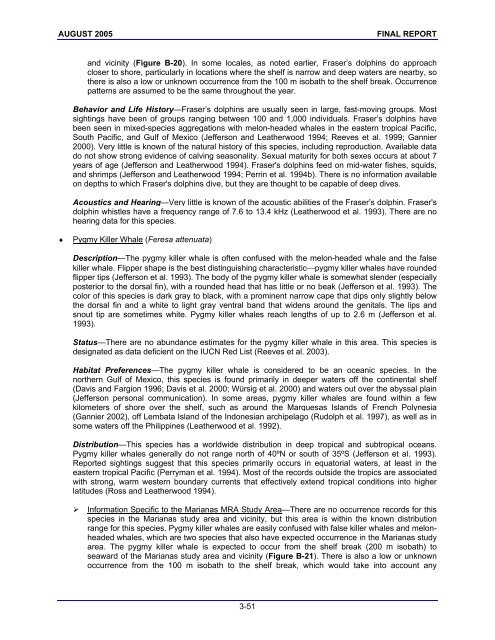Marine Resources Assessment for the Marianas Operating ... - SPREP
Marine Resources Assessment for the Marianas Operating ... - SPREP
Marine Resources Assessment for the Marianas Operating ... - SPREP
You also want an ePaper? Increase the reach of your titles
YUMPU automatically turns print PDFs into web optimized ePapers that Google loves.
AUGUST 2005 FINAL REPORT<br />
and vicinity (Figure B-20). In some locales, as noted earlier, Fraser’s dolphins do approach<br />
closer to shore, particularly in locations where <strong>the</strong> shelf is narrow and deep waters are nearby, so<br />
<strong>the</strong>re is also a low or unknown occurrence from <strong>the</strong> 100 m isobath to <strong>the</strong> shelf break. Occurrence<br />
patterns are assumed to be <strong>the</strong> same throughout <strong>the</strong> year.<br />
Behavior and Life History—Fraser’s dolphins are usually seen in large, fast-moving groups. Most<br />
sightings have been of groups ranging between 100 and 1,000 individuals. Fraser’s dolphins have<br />
been seen in mixed-species aggregations with melon-headed whales in <strong>the</strong> eastern tropical Pacific,<br />
South Pacific, and Gulf of Mexico (Jefferson and Lea<strong>the</strong>rwood 1994; Reeves et al. 1999; Gannier<br />
2000). Very little is known of <strong>the</strong> natural history of this species, including reproduction. Available data<br />
do not show strong evidence of calving seasonality. Sexual maturity <strong>for</strong> both sexes occurs at about 7<br />
years of age (Jefferson and Lea<strong>the</strong>rwood 1994). Fraser's dolphins feed on mid-water fishes, squids,<br />
and shrimps (Jefferson and Lea<strong>the</strong>rwood 1994; Perrin et al. 1994b). There is no in<strong>for</strong>mation available<br />
on depths to which Fraser's dolphins dive, but <strong>the</strong>y are thought to be capable of deep dives.<br />
Acoustics and Hearing—Very little is known of <strong>the</strong> acoustic abilities of <strong>the</strong> Fraser’s dolphin. Fraser's<br />
dolphin whistles have a frequency range of 7.6 to 13.4 kHz (Lea<strong>the</strong>rwood et al. 1993). There are no<br />
hearing data <strong>for</strong> this species.<br />
♦ Pygmy Killer Whale (Feresa attenuata)<br />
Description—The pygmy killer whale is often confused with <strong>the</strong> melon-headed whale and <strong>the</strong> false<br />
killer whale. Flipper shape is <strong>the</strong> best distinguishing characteristic⎯pygmy killer whales have rounded<br />
flipper tips (Jefferson et al. 1993). The body of <strong>the</strong> pygmy killer whale is somewhat slender (especially<br />
posterior to <strong>the</strong> dorsal fin), with a rounded head that has little or no beak (Jefferson et al. 1993). The<br />
color of this species is dark gray to black, with a prominent narrow cape that dips only slightly below<br />
<strong>the</strong> dorsal fin and a white to light gray ventral band that widens around <strong>the</strong> genitals. The lips and<br />
snout tip are sometimes white. Pygmy killer whales reach lengths of up to 2.6 m (Jefferson et al.<br />
1993).<br />
Status—There are no abundance estimates <strong>for</strong> <strong>the</strong> pygmy killer whale in this area. This species is<br />
designated as data deficient on <strong>the</strong> IUCN Red List (Reeves et al. 2003).<br />
Habitat Preferences—The pygmy killer whale is considered to be an oceanic species. In <strong>the</strong><br />
nor<strong>the</strong>rn Gulf of Mexico, this species is found primarily in deeper waters off <strong>the</strong> continental shelf<br />
(Davis and Fargion 1996; Davis et al. 2000; Würsig et al. 2000) and waters out over <strong>the</strong> abyssal plain<br />
(Jefferson personal communication). In some areas, pygmy killer whales are found within a few<br />
kilometers of shore over <strong>the</strong> shelf, such as around <strong>the</strong> Marquesas Islands of French Polynesia<br />
(Gannier 2002), off Lembata Island of <strong>the</strong> Indonesian archipelago (Rudolph et al. 1997), as well as in<br />
some waters off <strong>the</strong> Philippines (Lea<strong>the</strong>rwood et al. 1992).<br />
Distribution—This species has a worldwide distribution in deep tropical and subtropical oceans.<br />
Pygmy killer whales generally do not range north of 40ºN or south of 35ºS (Jefferson et al. 1993).<br />
Reported sightings suggest that this species primarily occurs in equatorial waters, at least in <strong>the</strong><br />
eastern tropical Pacific (Perryman et al. 1994). Most of <strong>the</strong> records outside <strong>the</strong> tropics are associated<br />
with strong, warm western boundary currents that effectively extend tropical conditions into higher<br />
latitudes (Ross and Lea<strong>the</strong>rwood 1994).<br />
In<strong>for</strong>mation Specific to <strong>the</strong> <strong>Marianas</strong> MRA Study Area—There are no occurrence records <strong>for</strong> this<br />
species in <strong>the</strong> <strong>Marianas</strong> study area and vicinity, but this area is within <strong>the</strong> known distribution<br />
range <strong>for</strong> this species. Pygmy killer whales are easily confused with false killer whales and melonheaded<br />
whales, which are two species that also have expected occurrence in <strong>the</strong> <strong>Marianas</strong> study<br />
area. The pygmy killer whale is expected to occur from <strong>the</strong> shelf break (200 m isobath) to<br />
seaward of <strong>the</strong> <strong>Marianas</strong> study area and vicinity (Figure B-21). There is also a low or unknown<br />
occurrence from <strong>the</strong> 100 m isobath to <strong>the</strong> shelf break, which would take into account any<br />
3-51
















